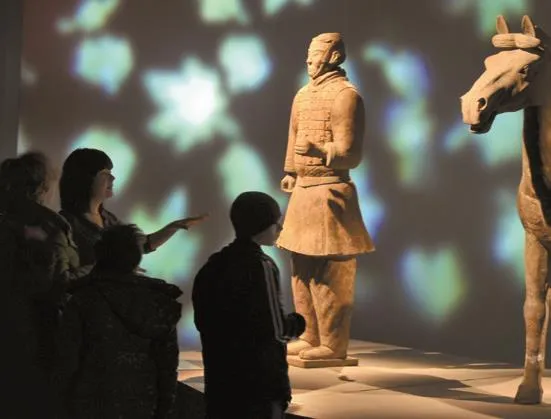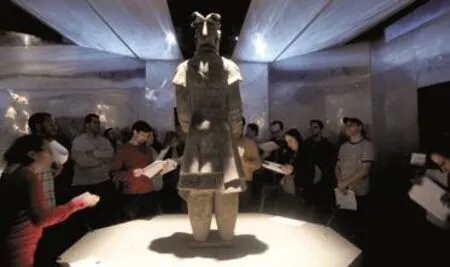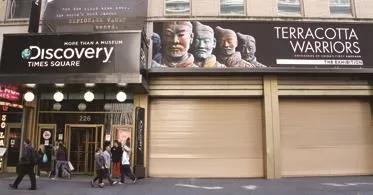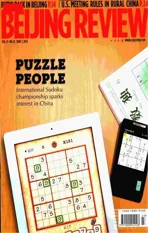Tomb With a View
2012-09-12ByCorrieDosh
By Corrie Dosh
Tomb With a View
By Corrie Dosh
China’s famed Terracotta Warriors conquer the Big Apple

ChiNESE iCoN: Visitors appreciate China’s terracotta Warriors displayed in New York’s Discovery Times Square museum at a preview of the exhibition on April 25
A 600-pound armored general from China has invaded New York City. He has come in peace, along with a few warriors of his army, some livestock, a horse, kitchen supplies and even an acrobat. Nearby, a kneeling archer practices his aim, with a spray of arrows fanning out on the wall ahead. The entourage seems appropriate, since it is the 2,200-year-old general’s first trip to the United States.
The selection of artifacts from the worldfamous Terracotta Warriors of Xi’an, capital of northwest China’s Shaanxi Province, made their debut on April 27 at New York’s Discovery Times Square museum. The exhibition, which will end on August 26, includes more than 20 artifacts that will be displayed in the United States for the frst time, including a set of gates from an ancient Han burial chamber (making their world debut), a cooking utensil and a bronze wine vessel. Ten of the life-sized clay warriors are on display—the maximum amount that can be displayed outside of China at one time.
“The terracotta warriors, for an American audience, are one of the icons of Chinese culture and archeological history. They are recognized throughout the world,” said Sara Judge McCalpin, President of New Yorkbased China Institute, a sponsor of the Terracotta Warriors exhibit. “You can actually see these warriors and you don’t have to go all the way to Xi’an.”
The terracotta army, including an estimated 8,000 life-sized warriors, was buried with China’s first Emperor Qin (259-210 B.C.), who unifed the country and built key sections of the Great Wall. Construction of the tomb began in 246 B.C., not long after he assumed the throne. The New York exhibit is part art gallery, part history lesson, and visitors wind their way through three sections, each highlighting a different phase in the history of the Qin Dynasty (221-206 B.C.): The Rise of Qin, The Terracotta Army, and The Harmonious Han.
Qin’s armored general stands alone in a shimmering room of silver, an illustration of the “rivers of quicksilver” that surrounded the emperor in his tomb—mercury that artisans used to recreate the empire’s great Yangtze and Yellow rivers. These rivers of toxic mercury may have been designed to repel grave robbers. The emperor himself may have died from mercury poisoning after drinking cinnabar, a natural source of the metal.
The exhibit offers just a glimpse of the archeological treasures that were accidentally unearthed in Xi’an in 1974. Thousands of clay warriors remain buried at the site, all individually created and dressed for battle, with hundredsof life-sized horses and chariots, entertainers, musicians and officials. The emperor’s tomb, the size of a football feld, remains unopened.

A terracotta Warrior on display in New York

thE DEbUt: A billboard outside Discovery Times Square advertises the opening of China’s exhibition—terracotta Warriors: Defenders of China’s First Emperor—in New York on April 27
“For anyone that sees them there (in Xi’an), the sheer enormity and sheer number of warriors give one an understanding of the incredible talent to make all of these statues, and there’s something quite monumental about seeing them all lined up,” McCalpin said.
The exhibition was created and produced jointly by the Discovery Times Square museum, the China Institute, the Shaanxi Provincial Cultural Relics Bureau (SPCRB) and the Shaanxi Provincial Museum Association (SPMA). It was curated by archeology expert and historian Chen Shen, Vice President and Senior Curator at the Royal Ontario Museum. The exhibit is a multimedia, immersive experience, with films showing reenactments of ancient battles and dramatic lighting that creates a tomb-like experience.
“(The China Institute) has been enhancing the understanding of China in the United States since 1926, so (the exhibit) very much fits with our mission of teaching Americans about China,” said McCalpin. Since the founding of the China Institute, interest in Chinese culture “has only grown,” she added, and the U.S.-China relationship has become “the most important relationship of the 21st century.”
“I believe that’s the reason why there is such growing interest in Chinese culture, history and language,” McCalpin said.
The China Institute has several current and upcoming exhibitions on Chinese art and culture, including a showing of tomb décor of the Jin Dynasty (266-420) from Shaanxi Province. New Yorkers will have the chance to see an exhibition of modern Chinese porcelain this fall, and an exhibition of artifacts from Dunhuang in Gansu Province in 2013.
With each exhibition, the institute hopes to advance its mission of giving Americans the chance to experience a little bit of China, McCalpin said. If the crowds at the Terracotta Warriors exhibit are any indication, interest in Chinese culture is at an all-time high.
“It’s a great honor to have the opportunity to work with these legendary artifacts and craft a one-of-a-kind experience immersing visitors into a time that was so influential in shaping China’s history. We are proud to partner with New York’s China Institute, the SPCRB, and the SPMA to present these artifacts here in the heart of Times Square,” said James Sanna, CEO of Discovery Times Square, in a release.
The author is a freelance writer living in New York City
liuyunyun@bjreview.com
